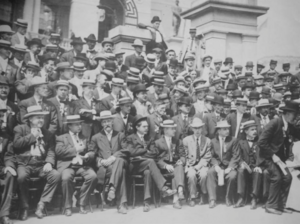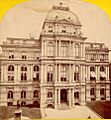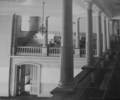Old City Hall (Boston) facts for kids
|
Old City Hall
|
|
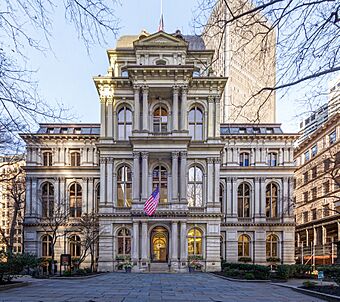
Old City Hall in 2024
|
|
| Location | 45 School Street Boston, Massachusetts, U.S. |
|---|---|
| Built | 1862–1865 |
| Architect | G. J. F. Bryant, A. D. Gilman |
| Architectural style | Second Empire |
| NRHP reference No. | 70000687 |
Quick facts for kids Significant dates |
|
| Added to NRHP | December 30, 1970 |
| Designated NHL | December 30, 1970 |
Old City Hall is a famous building in Boston, Massachusetts. It's located at 45 School Street. For over 100 years, from 1865 to 1969, this building was where the Boston City Council met. It was designed by two architects, Gridley James Fox Bryant and Arthur Gilman.
This building was one of the very first in the United States to use the French Second Empire style. This style became very popular after Old City Hall was built. You can see similar designs in many other important buildings across the U.S. These include the Eisenhower Executive Office Building in Washington, D.C., and city halls in Providence, Baltimore, and Philadelphia.
Contents
A Look Back: Old City Hall's History
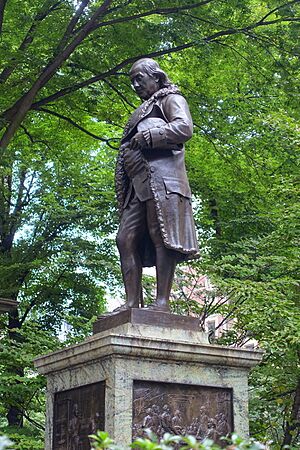
Old City Hall was built between 1862 and 1865. It stands on School Street, right along the historic Freedom Trail. This path connects many important sites in Boston. Before this building, the famous Boston Latin School was on this very spot from 1704 to 1748.
Later, a courthouse was built here in 1810. It became Boston's second city hall in 1841. Then, the Old City Hall we see today replaced it 24 years later. Many important people worked here. Thirty-eight different mayors of Boston served their terms in this building. Famous mayors like John F. Fitzgerald and James Michael Curley worked on School Street.
In 1969, the city government moved to a new Boston City Hall. Old City Hall was then given a new life. Over the next two years, it was changed to hold different businesses and offices. This is a great example of "adaptive reuse." It means finding new ways to use old buildings. The Architectural Heritage Foundation helped make this change.
Because of its history and unique style, Old City Hall was recognized as a U.S. National Historic Landmark in 1970. It was also added to the National Register of Historic Places.
Cool Architectural Features
Old City Hall has many interesting details to see:
- The outside is made of granite. It has fancy columns, a special type of roof called a mansard roof, and a part that sticks out in the middle.
- The huge front doors are special. They use different kinds of wood and have a marble circle design.
- Inside the entrances, you can see murals. These paintings show the history of the building and the land it sits on.
- A marble plaque in the lobby remembers when the first stone was laid in 1862. It also honors the building's opening in 1865.
- Look for a hopscotch game on the School Street sidewalk! It reminds everyone that this was once the site of the Boston Latin School.
- The statues in the courtyard are very special:
- There's a statue of Benjamin Franklin. He actually went to school on this site! The statue shows scenes from his life on its base. This statue, made in 1856, was the first portrait statue in Boston. It shows Franklin as he really looked, not dressed in old-fashioned robes.
- You'll also see a statue of Josiah Quincy III. He was Boston's second mayor. This statue was made in 1879.
- There's even a statue of a donkey! This donkey is a symbol of the Democratic Party. In front of it, you'll find two bronze footprints that say "stand in opposition." A plaque explains how the donkey became a party symbol.
Old City Hall Today
Today, Old City Hall is a busy place. In 2017, Synergy Investments bought the building. It has more than 83,000 square feet of space. Now, it's home to many different businesses and organizations. You can find a Ruth's Chris Steak House, Welch & Forbes, and other companies there. A famous French restaurant called Maison Robert used to be there but closed in 2004.
Mayors Who Served in Old City Hall
Many important mayors led Boston from this historic building. Here are some of them:
- Frederic W. Lincoln Jr. (1863–1866)
- Otis Norcross (1867–1868)
- Nathaniel B. Shurtleff (1868–1871)
- William Gaston (1871–1872)
- Henry L. Pierce (1873)
- Leonard R. Cutter (1873)
- Samuel C. Cobb (1874–1876)
- Frederick O. Prince (1877)
- Henry L. Pierce (1878)
- Frederick O. Prince (1879–1881)
- Samuel A. Green (1882)
- Albert Palmer (1883)
- Augustus P. Martin (1884)
- Hugh O'Brien (1885–1888)
- Thomas N. Hart (1889–1890)
- Nathan Matthews Jr. (1891–1894)
- Edwin Upton Curtis (1895)
- Josiah Quincy (1896–1899)
- Thomas N. Hart (1900–1902)
- Patrick Collins (1902–1905)
- Daniel A. Whelton (1905–1906)
- John F. Fitzgerald (1906–1908, 1910–1914)
- George A. Hibbard (1908–1910)
- James M. Curley (1914–1918, 1922–1926, 1930–1934, 1946–1950)
- Andrew J. Peters (1918–1922)
- Malcolm Nichols (1926–1930)
- Frederick Mansfield (1934–1938)
- Maurice J. Tobin (1938–1945)
- John E. Kerrigan (1945–1946)
- John B. Hynes (1947, 1950–1960)
- John F. Collins (1960–1968)
- Kevin H. White (1968–1984)
Images for kids
-
Old Suffolk County Courthouse and Boston's City Hall 1841 to 1865
More to Explore
- Boston City Council
- Boston City Hall – This is Boston's current city hall building.
- List of mayors of Boston
- List of National Historic Landmarks in Boston




